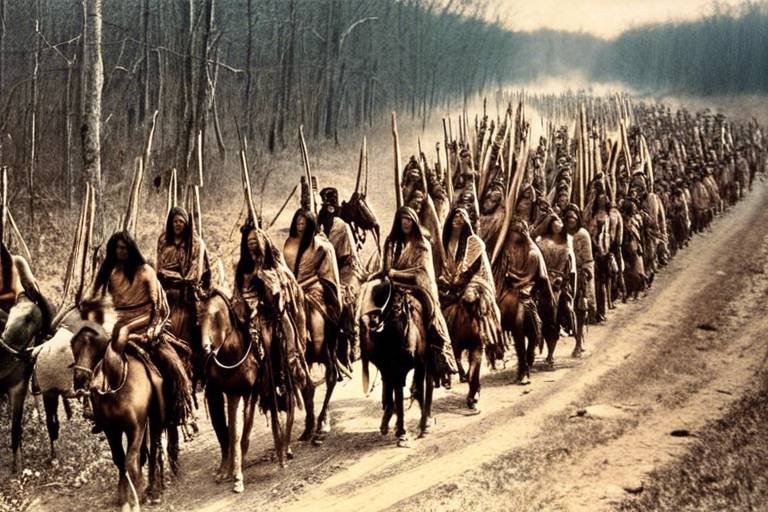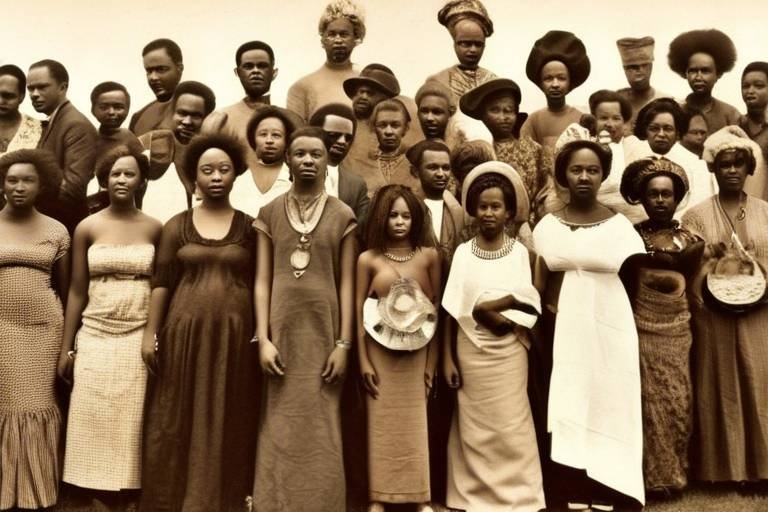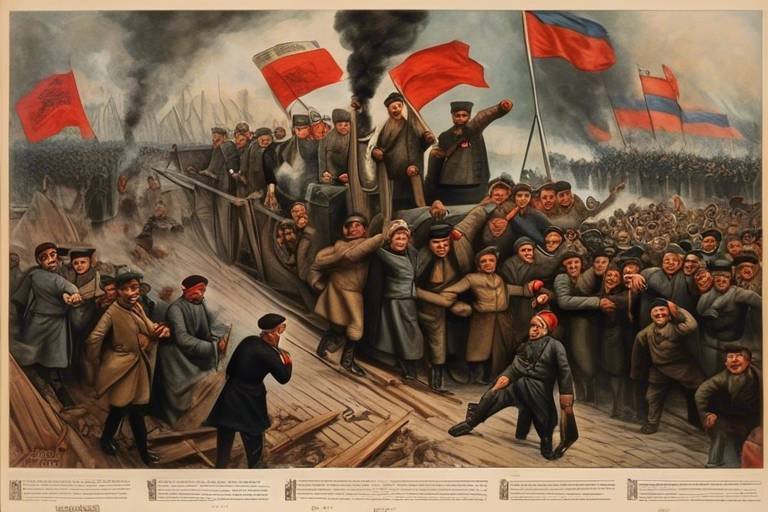The Trail of Tears - Forced Relocation of Native Americans
When delving into the dark chapters of American history, one cannot overlook the harrowing tale of the Trail of Tears. This tragic event marks the forced relocation of Native American tribes, predominantly the Cherokee, from their cherished ancestral lands to distant territories in the west. The Trail of Tears stands as a poignant reminder of the injustices inflicted upon indigenous peoples and the enduring resilience of Native American communities.

Background of the Trail of Tears
The Trail of Tears stands as a dark chapter in American history, marked by the forced relocation of Native American tribes from their ancestral lands to the west. This tragic event was a culmination of years of discriminatory policies and actions by the U.S. government towards indigenous peoples. The roots of the Trail of Tears can be traced back to the Indian Removal Act of 1830, signed into law by President Andrew Jackson. This act authorized the removal of Native American tribes from their lands in the southeastern United States, paving the way for the devastating journey that would follow.
Driven by a combination of political, economic, and ideological motives, the U.S. government sought to clear the southeastern lands for white settlement and expand its control over valuable resources. The concept of Manifest Destiny, the belief that the United States was destined to expand across the continent, fueled the push for Native American removal. The forced relocation of indigenous peoples was not only a violation of their rights but also a reflection of the prevailing attitudes of the time towards Native Americans.
As tensions escalated between Native American tribes and the U.S. government, resistance to removal grew. The Cherokee Nation, in particular, fought against forced relocation through legal means, challenging the constitutionality of the Indian Removal Act. The Supreme Court case of Worcester v. Georgia in 1832 affirmed the sovereignty of Native American tribes, but President Jackson famously disregarded the ruling, leading to the enforcement of removal policies.
The Trail of Tears was not a singular event but a series of forced marches that affected multiple tribes, including the Choctaw, Chickasaw, Creek, and Seminole. These tribes faced immense hardships during their journeys to the west, enduring harsh conditions, disease, and loss of life along the way. The forced removal disrupted tribal communities, fractured cultural ties, and inflicted lasting trauma on generations of Native Americans.

Cherokee Nation and Removal
When it comes to the Cherokee Nation and the tragic events of forced removal, a tale of resilience and tragedy unfolds. The Cherokee people, deeply rooted in their ancestral lands, faced the relentless push for relocation by the U.S. government. Despite their efforts to resist, including legal battles in the Supreme Court, the Cherokee Nation ultimately succumbed to the enforcement of relocation under President Andrew Jackson.
Imagine a community torn from their homes, their traditions, and their way of life, forced to embark on a treacherous journey known as the Trail of Tears. The Cherokee people, like many other Native American tribes, experienced unimaginable hardships as they were uprooted from familiar territories and thrust into unfamiliar lands in the west.
The forced removal of the Cherokee Nation was not merely a physical relocation but a profound disruption of their cultural identity. Families were torn apart, ancestral connections severed, and the fabric of their society torn asunder. The scars of this traumatic experience continue to resonate within the Cherokee community to this day.
As the Cherokee people grappled with the aftermath of forced removal, they found themselves navigating a new reality fraught with challenges. The loss of life, the erosion of cultural heritage, and the struggle for survival in unfamiliar terrain marked a dark chapter in Cherokee history that can never be forgotten.
Despite the immense hardships endured by the Cherokee Nation, their spirit endured. Today, the Cherokee people stand as a testament to resilience and strength, honoring their ancestors who suffered on the Trail of Tears. Their journey serves as a poignant reminder of the injustices inflicted upon Native American communities and the enduring legacy of survival against all odds.

Choctaw and Chickasaw Removal
The forced removal of the Choctaw and Chickasaw tribes from their ancestral lands marked a dark chapter in American history, known as the Trail of Tears. These tribes, like the Cherokee, faced immense hardships and tragedies during their relocation to the west. The Choctaw, one of the Five Civilized Tribes, were the first to be forcibly removed from their homelands in the southeastern United States.
As the Choctaw embarked on the arduous journey, they experienced profound suffering due to harsh weather conditions, lack of adequate food and shelter, and the spread of diseases. Many Choctaw people lost their lives along the trail, further deepening the sorrow and trauma of the forced removal.
Similarly, the Chickasaw tribe also endured immense challenges during their relocation. Forced to leave behind their homes, traditions, and way of life, the Chickasaw people faced uncertainty and despair as they were pushed towards unfamiliar territories in the west.
The Choctaw and Chickasaw removal exemplifies the profound impact of the Trail of Tears on Native American communities. The loss of lives, destruction of cultural heritage, and displacement of entire tribes underscore the devastating consequences of the forced relocations mandated by the U.S. government.

Creek and Seminole Removal
When examining the Creek and Seminole tribes' experiences during the era of forced relocation, a complex narrative of resistance and conflict emerges. The Creeks, also known as the Muscogee, faced significant challenges as they resisted the pressure to leave their ancestral lands in the southeastern United States. Despite signing treaties with the U.S. government to retain their territory, the Creek Nation found themselves embroiled in disputes that ultimately led to their removal.
Similarly, the Seminole tribe of Florida fiercely resisted efforts to relocate, resulting in the outbreak of the Second Seminole War in 1835. This conflict, which lasted for several years, highlighted the Seminoles' determination to remain on their land and defend their way of life. The U.S. government's military campaigns against the Seminoles were met with guerrilla tactics and strategic retreats, prolonging the conflict and resulting in significant loss of life on both sides.
As the Creek and Seminole tribes grappled with the devastating impacts of forced removal, their resilience and perseverance in the face of adversity became emblematic of the broader struggle of Native American communities during this dark chapter in history. The stories of the Creeks and Seminoles serve as poignant reminders of the profound injustices inflicted upon indigenous peoples through policies of forced relocation and assimilation.

Impact on Native American Communities
The Trail of Tears had a profound impact on Native American communities, leaving a trail of devastation in its wake. The forced relocation resulted in immeasurable loss of life, as many tribe members succumbed to disease, starvation, and harsh conditions along the arduous journey. Families were torn apart, traditional ways of life were disrupted, and the very fabric of Native American societies was forever altered.
Furthermore, the Trail of Tears led to a significant erosion of tribal sovereignty, as Native American nations were forcibly removed from their ancestral lands and confined to unfamiliar territories in the west. This displacement not only deprived them of their homes and livelihoods but also undermined their ability to govern themselves and maintain their cultural practices.
The trauma inflicted by the Trail of Tears reverberated through generations, perpetuating a cycle of poverty, disenfranchisement, and social marginalization within Native American communities. The loss of traditional knowledge, languages, and customs further deepened the wounds inflicted by this dark chapter in American history.
Despite the passage of time, the legacy of the Trail of Tears continues to cast a long shadow over Native American communities, serving as a stark reminder of the injustices perpetrated against indigenous peoples. Efforts to acknowledge and address the lasting effects of this forced relocation remain ongoing, as advocates push for recognition, restitution, and healing in the pursuit of justice and reconciliation.

Legacy of the Trail of Tears
The legacy of the Trail of Tears continues to cast a long shadow over Native American history, serving as a stark reminder of the injustices and atrocities committed against indigenous peoples. The forced relocation of Native American tribes, including the Cherokee, Choctaw, Chickasaw, Creek, and Seminole, has left deep scars that are still felt today.
One of the most significant legacies of the Trail of Tears is the profound loss of life and suffering endured by Native American communities during the forced marches westward. Thousands perished due to harsh conditions, disease, and starvation, leaving behind a trail of devastation and heartbreak.
Furthermore, the Trail of Tears resulted in a profound disruption of Native American cultures and ways of life. The forced removal from ancestral lands severed ties to traditional practices, languages, and spiritual beliefs, leading to a loss of cultural identity that continues to impact tribes to this day.
In addition to the immediate impact on Native American communities, the Trail of Tears had long-term consequences for tribal sovereignty and self-governance. The forced relocation set a dangerous precedent for the violation of indigenous rights and sovereignty, paving the way for further encroachments on tribal lands and autonomy.
The legacy of the Trail of Tears also underscores the ongoing struggle for recognition, justice, and reparations by Native American tribes and communities. Efforts to acknowledge the historical injustices of the Trail of Tears and seek restitution for the damages inflicted continue to be important issues in contemporary Native American activism and advocacy.
As we reflect on the legacy of the Trail of Tears, it serves as a somber reminder of the dark chapters in American history and the enduring resilience of Native American peoples in the face of adversity. The lessons learned from this tragic event compel us to confront the injustices of the past and work towards a more equitable and inclusive future for all.
Frequently Asked Questions
- What was the Trail of Tears?
The Trail of Tears refers to the forced relocation of several Native American tribes, including the Cherokee, Choctaw, Chickasaw, Creek, and Seminole, from their ancestral lands to designated territories in the west during the 1830s. This tragic event resulted in the displacement and suffering of thousands of indigenous people.
- Why was the Trail of Tears significant?
The Trail of Tears is significant as it represents a dark chapter in American history where the U.S. government forcibly removed Native American tribes from their lands, leading to immense loss of life, cultural disruption, and long-term consequences for tribal sovereignty. The event highlights the injustices and hardships faced by indigenous communities in the face of westward expansion.
- What was the impact of the Trail of Tears on Native American communities?
The Trail of Tears had a devastating impact on Native American communities, resulting in the loss of thousands of lives, the destruction of traditional ways of life, and the undermining of tribal autonomy. The forced relocation led to profound trauma and suffering among the affected tribes, leaving a lasting legacy of pain and resilience.



















